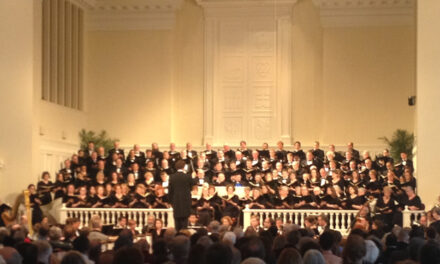Big names bring in big crowds, and Anne-Sophie Mutter is one that causes great excitement even in the major music capitals around the world. Carolina Performing Arts presented the great violin diva, accompanied by Camerata Salzburg, a strings-only chamber orchestra, in a program consisting of the violin concerti of J.S. Bach. It had all the feel of a gala event at UNC Chapel Hill’s Memorial Auditorium as we were only one of a few select cities on this U.S. tour to help promote a new recording featuring these very same works.
As is the custom in most non-American orchestras, all the players came onstage right before the start of the program, rather than sitting around and getting in some last minute practicing before a paying audience. After some very fast and efficient tuning, Ms. Mutter walked out – quite stately and regal in a steel-grey gown – and immediately launched into the opening of Bach’s Concerto No. 1 in A minor. Camerata Salzburg, a fifty year old institution, inhabits a middle-ground between the harsh, often uncompromising orthodoxy of “period instrument” dogma, and the “modern” orchestral sound. Using the more palatable terminology/acronym “HIP” (Historically Informed Performance), this orchestra thankfully does not consider vibrato the anti-Christ and plays with modern bows and strings. What they bring to these works is a crisp and crystalline articulation, fifth-gear tempi, but also the ability to switch to a broad and warm sound in slower movements.
Mutter is one of the few soloists that Herbert Von Karajan, late conductor of the Vienna Philharmonic, championed and mentored. As Karajan was, Mutter is a study in austerity and restrained intensity, although she used her body and head to great effect in conducting the ensemble when she wasn’t consumed with playing passages at warp speed. Her facial expression almost never changed regardless of the tempo or character of the music. She is a player with remarkable efficiency, control and dynamic shadings that brought an inner life and profundity to these Baroque masterpieces.
She played the two solo violin concerti (in A minor and E major) that are both in the traditional slow-fast-slow configuration. At the start of most of the fast movements one stepped through several stages of denial: 1. No way – this tempo can never be sustained. 2. Even if it can, it’s just way too fast – almost clownish. 3. Wow! She’s doing it – cleanly. 4. This is the way it should be played.
Mutter shared the stage for the famous Double Concerto for two violins with Vilde Frang, a twenty-one year old from Norway who is well on her way to a major international career. Frang is a more effusive player than Mutter, but both were well in synch for this well-known Bach creation. They were especially effective in the lovely, but longish, adagio movement where each displayed their beautiful tone and sensitive phrasing.
The evening ended with somewhat of a curiosity: an orchestral arrangement of the famous Violin Sonata in G minor (“The Devil’s Trill”) by Tartini. Originally for violin and keyboard, the arrangement seemed heavy, ponderous and out-of-character. Of course Mutter’s performance was anything but that. The subtitle of this work is for good reason, as it is just filled with trills (rapid, left-hand embellishments of a note), something which even for short stretches can make a player feel like his muscles are being torn out of his arm. This goes on, including double-stop trills, for nearly the entire work and was played with as much precision, energy and speed in the last one as the first. Actually, this can be played without accompaniment of any kind and would have been just as complete and spectacular.
Mutter spoke her only words of the evening; a simple, but appropriate “more Bach” as she encored with the lovely Air on the G String from Bach’s third orchestral suite. One of Bach’s most famous melodies, Mutter’s evocative and heartfelt playing served as a gentle landing from the seemingly unsustainable heights of fire and velocity that came before.












